Our next destination was the infamous Rome. Capitol of the ancient Roman Empire, home to an immense amount of church history, and neighbor to the Vatican (home of the Pope). Rome is full of history, pasta, pizza, and gelato, and yes, it’s a lovely place to visit :).
As I mentioned in a previous blog, this was my second visit to Rome, but Kirk’s first time to enter into the city. I wish you all could have seen his face as he walked around this city of ruins. Every block holds a new (old) column, wall, bath complex, or temple. The old empire lies roped off and built into the modern day structures of the city. As a history major, Kirk soaked every bit of it and it was fun to watch him do so.
As luck would have it, the first place we ended up visiting in Rome was the Colosseum. We’d spent quite a lot of time trying to figure out when the best time to go would be as our time in Rome was limited to just a few days. As with most tourist attractions in Rome, the lines to get into the structure are often wrapped far around the building and you can end up waiting for longer outside the Colosseum then you spend checking out the inside. As we arrived at the city center our first night there, we walked by the colosseum in search of food and noticed that the line didn’t even exceed the inner columns of the building. With an hour and a half left til closing, we hoped in line and were inside within 15 minutes. Unbelievable, and plenty of time to explore this enormous structure constructed by 80 AD.
The Colosseum was once the center of appeasement in Rome. It provided free entertainment for the masses by means of gladiator fights to the death and wild animal brawls. Prisoners deemed worthy of death were thrown to wild cats here as the empire watched them run and fight for their lives. It sounds gross and gory and, well, in some ways, not so different than what’s on our televisions, except that it was real life.
To be honest, the first time I visited the Colosseum I thought it was cool, but I was a little underwhelmed. While impressive, compared to modern day arenas, the Colosseum is quite small. However, visiting the colosseum this time was a completely different experience. Having visited so many ruins with arenas, amphitheaters, and colosseums of their own all over the world, my mind was no longer focused on the last football stadium in which I’d found myself, but rather, on other ancient structures. Compared to other ancient structures, the Colosseum in Rome is enormous – and intact. There is a reason it’s pictured all over tourist brochures and postcards, as it beckons to be seen! Below are some photos from our walk around it.

Just inside the entrance, the enormous arches in view
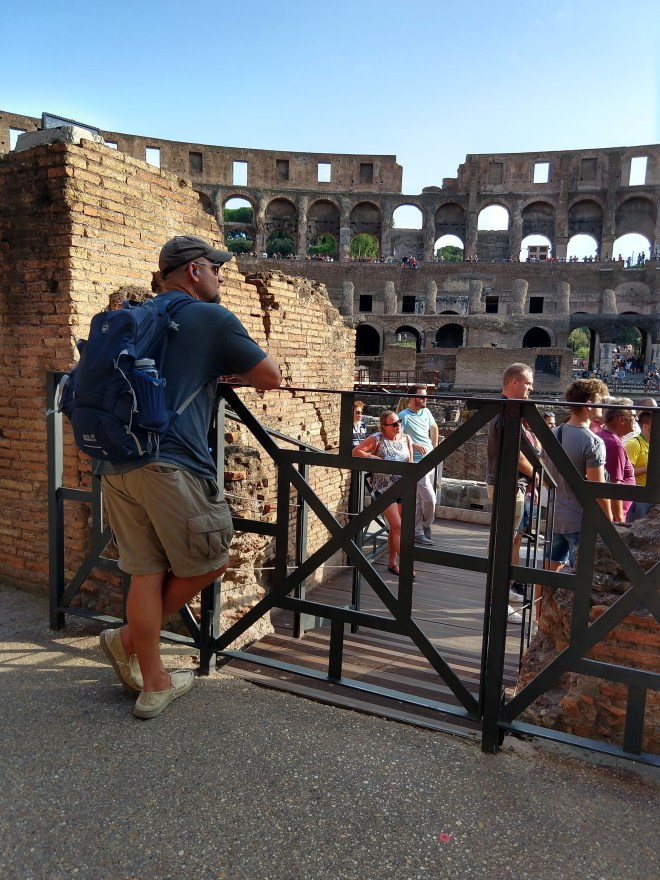
Kirk, getting his first glimpses of the inside
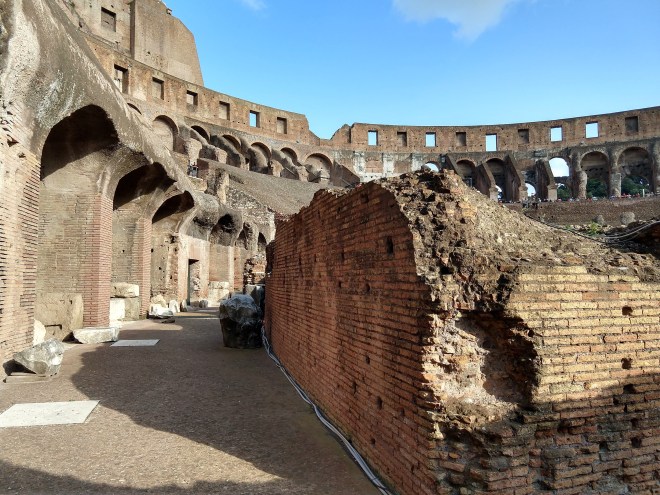
Arches on the top level of the Colosseum
 Panorama of the inside
Panorama of the inside

View from the top level of the Colosseum.
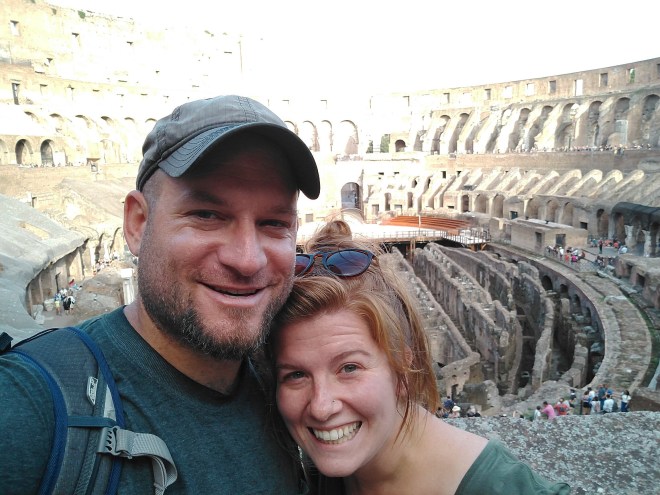
Selfie inside the Colosseum
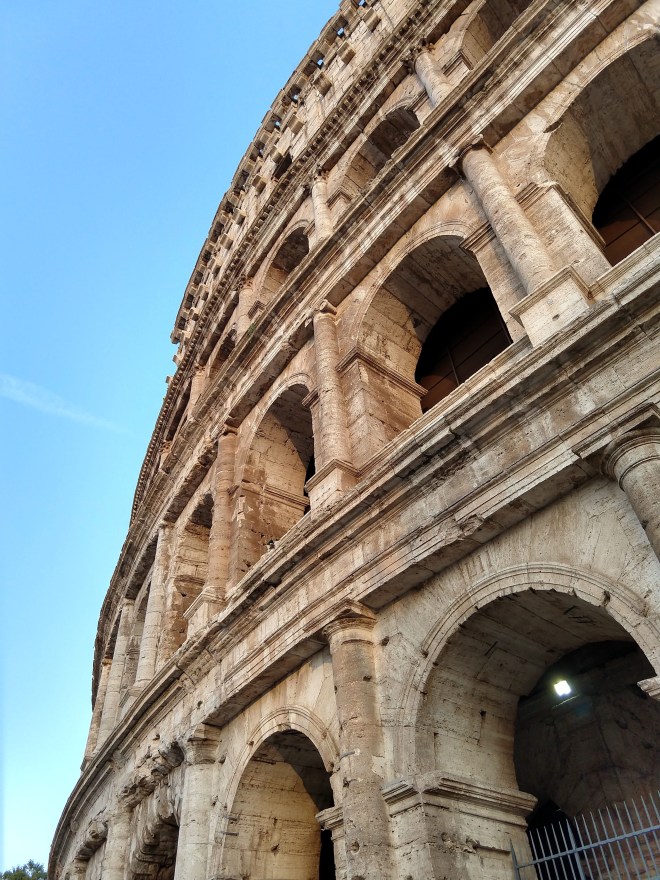
Outside the Colosseum
After visiting the Colosseum, we found some delicious food to dig into. We ended up getting calzone and a pasta dish called cacio y pepe. Cacio y pepe is a famous pasta dish in Rome made only with a bit of the starch water in which the pasta was boiled, fresh (rich) pecorino Romano cheese, and cracked black pepper. It’s delicious, and though it certainly can’t be called healthy, it doesn’t have the heavy cream of an Alfredo, which certainly makes me feel a little better about eating it 😂.
Truth be told, the dish pictured below was cacio y pepe with a twist – a little lime, pistachio, and a splash of cream, but hey, we got to real thing later 🤷♀️.
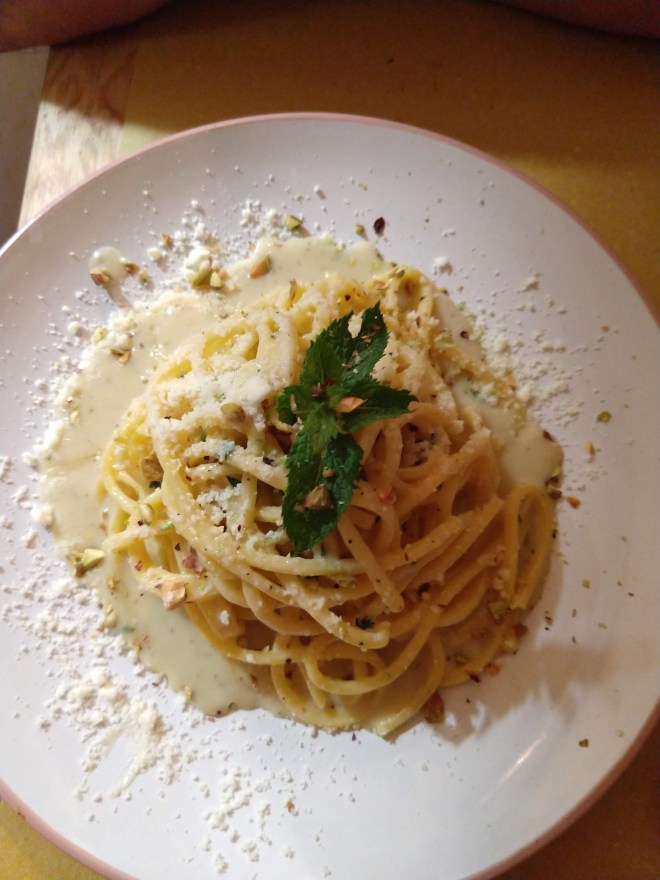
Cacio y pepe with a twist
Rome has four churches that are considered the most important (of the many, many churches) in the city. Three of these churches rest on what are believed to be the bones of their namesake, and though we did eventually end up visiting all four, one of these churches ended up being located two blocks from our Airbnb – the Basilica of St. Paul.
The Basilica of St. Paul was originally built in 324, but after catching fire it was rebuilt in the 1800’s. Right at the altar of the church are what are traditionally believed to be the chains of Paul from when he was arrested, as well as his gravesite.

The front of the sanctuary with a statue of Paul in front.
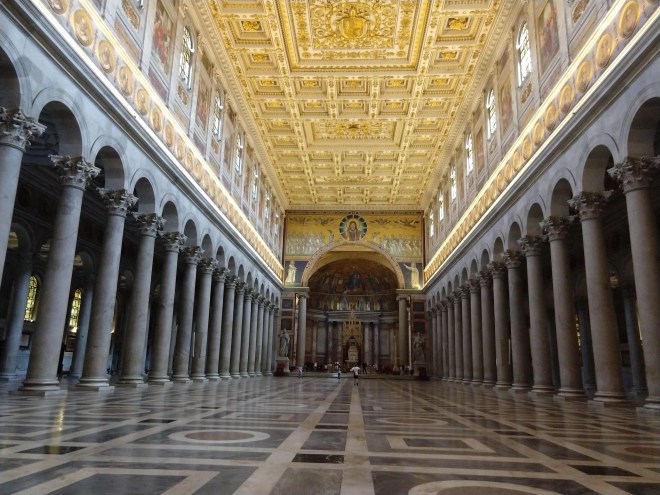
The middle of the sanctuary where chairs are set up on Sundays.

What are believed to be the chains and grave of Paul.
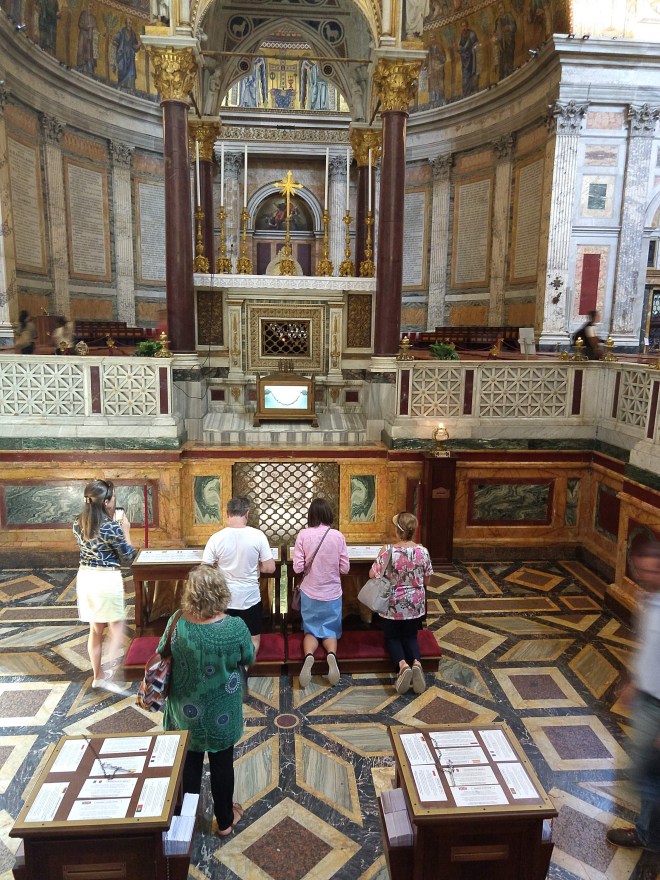
A full picture of the alter built above Paul’s grave and chains.
After visiting St. Paul’s, we decided to head out to another of these four important churches, the Archbasilica of Saint John the Lateran. Though I would have originally thought that St Peter’s Basilica, inside the Vatican, might be considered the most important church of these four important churches, it’s actually this one. This church is the church of the Pope, who also holds the title of Bishop of Rome. If you are lucky, you can find the Pope here giving mass or sharing a sermon on occasion when he is in town.

The front of St. John the Lateran’s.
Truth be told, this church happens to be my favorite of the 4 important churches. The statues in this sanctuary have stood out in my mind more than any other piece of art I’ve seen in a church. They are large, well done, and each depicts an apostle or leader of the church with some well known aspect about them. Peter, for example, holds a set of keys, depicting Matthew 16:19 when Peter is given the keys to heaven.
The statue below is of Bartholomew. Church tradition says the Bartholomew was skined alive for his belief in Christ. He is carved in marble below with a knife and his own flayed face in hand.

Bartholomew, face in hand

A view of the statues and sanctuary from where the Pope would preach.
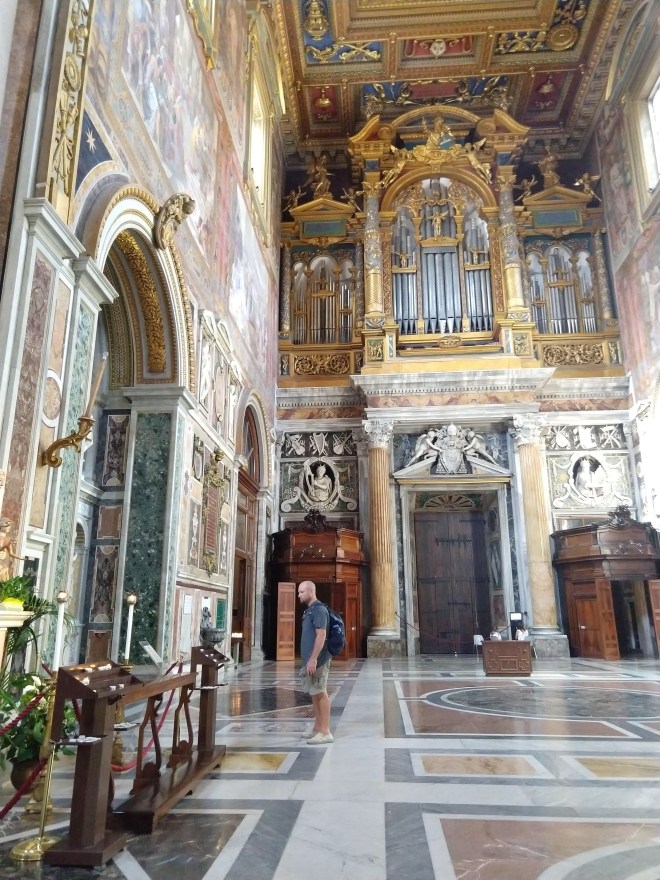
In the hall behind the altar with more art and the organ.
Just across the street from St John the Lateran is a place once known as the holiest place in the world. Once the home to relics of all kinds, what now remains is room with an altar at the top of the “Holy Stairs”. Traditionally, these Holy Stairs are believed to have been the stairs that Jesus climbed on his way to see Pontius Pilate. It’s said that they were later moved to this location and many people now make the long pilgrimage to Rome to climb these stairs one by one on their knees as they pray. For those unable or unwilling to go up the stair on their knees, two sets of stairs line the sides of the original that also lead up to the room once considered the most Holy place in the world. Though the actual holy stairs are currently under repair, we were able to walk up the side stairs to view the Holy room.
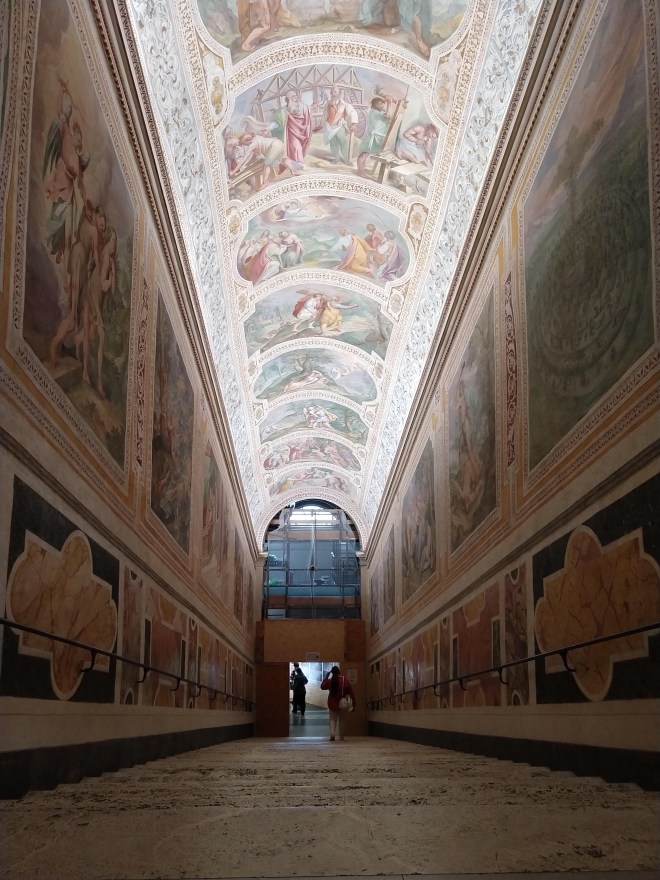
The side stairs that actually look quite similar to the Holy stairs, as the Holy stairs have been covered over with wood for protection of the original stairs.
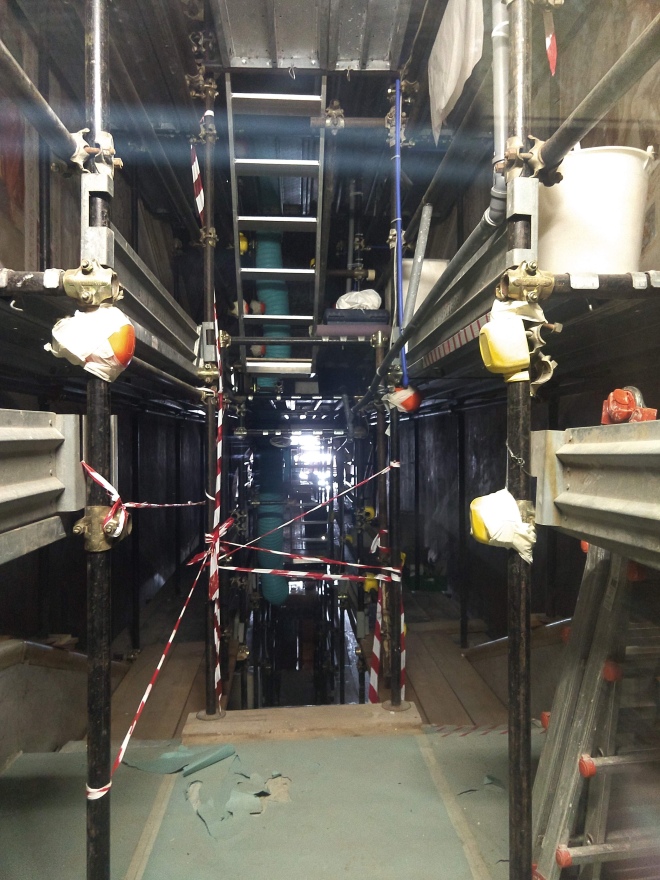
A peek into the construction going on around the actual “Holy Stairs”
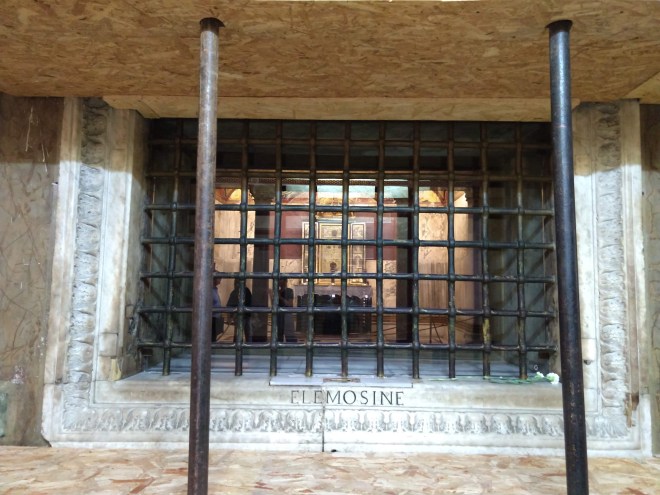
A window into what was once called the “holiest place in the world”
After visiting these churches we headed to another main attraction in Rome, the Roman Forum. This large area was once the center of the Roman Empire, home to humongous temples, political speeches, marketplaces, parliament meetings, criminal trials, and everyday life. All those famous Romans you learned about in history did business here and it’s even the location where Julius Caesar’s body was burned after he was assassinated. There is so much known history here.
First photo, the Arch of Titus

Arch of Titus
Around 66 AD a group of Judean Rebels sought control over the Roman controlled Judea State. They rebelled against the Roman Empire and gained control for a brief time before the Roman Empire came in and crushed the rebellion. The Arch of Titus was constructed in 82 AD after the rebels had been captured and turned into slaves. These Jewish slaves were forced to build this arch commemorating their defeat.
Side note – these Jewish rebellions tie into the Maccabean rebellion (a couple of hundred years before) – which is what the celebration of Hanukkah came out of.
Next, we saw an enormous building finished by Constantine.

Basilica of Maxentius and Constantine – built in the 300’s – though only one section of this building remains, it’s enormous, and was the largest building in the forum in it’s time.

Temple of Romulus – built in the 300’s with the original doors still on display. This beautiful green doors are around 1700 years old!

Temple of Antonius and Faustina, built in 141 AD, now made into a Catholic Church.
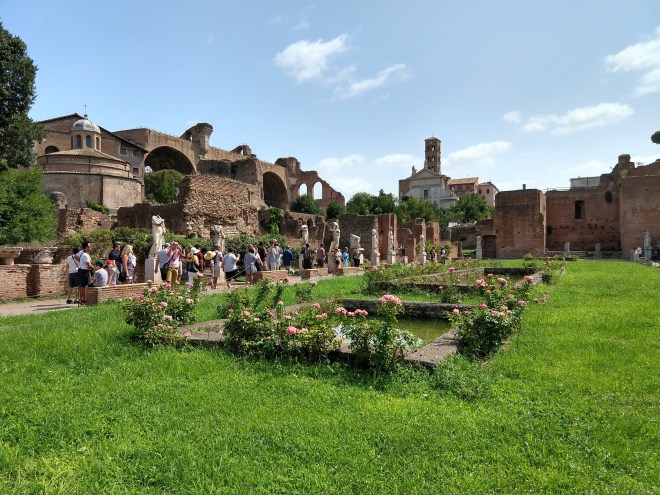
Inside the Vestal Virgin’s home – the location in the middle of the Forum where selected girls served as ceibate priestesses who enjoyed power and privilege far above most of the empire. They could vote, own property, had the best seats at gladiator games, and even had the power to pardon criminals. It wasn’t all good though – if they were suspected of losing their celibacy (which wasn’t always true) the penalty was being buried alive.
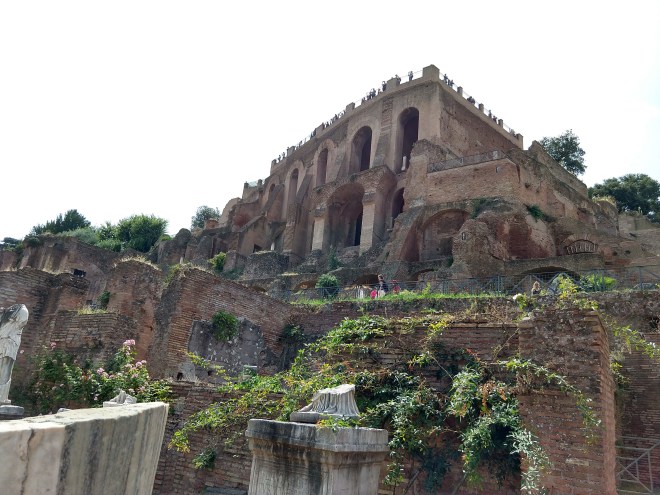
Palatine Hill – the palace overlooking the Roman Forum

Rostra – speaking podium of the Roman Forum. Many political speeches would have been made from here.
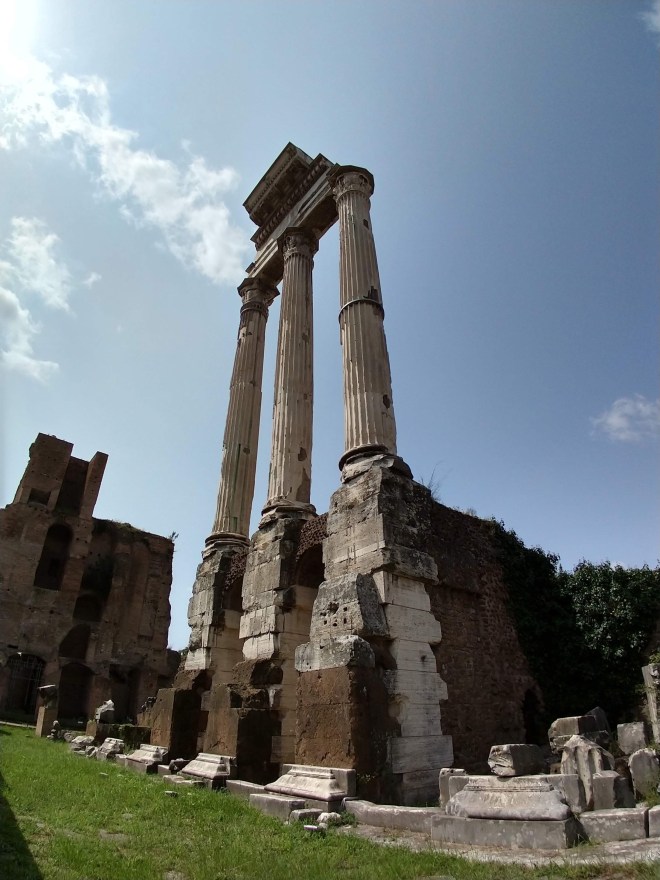
Temple of Castor and Pollux – the twin sons of Zeus and Leda

The location Julius Caesar’s body was burned – right in the middle of the Forum!

A wider view of part of the Forum.

A panoramic of the forum from the top of Palatine Hill
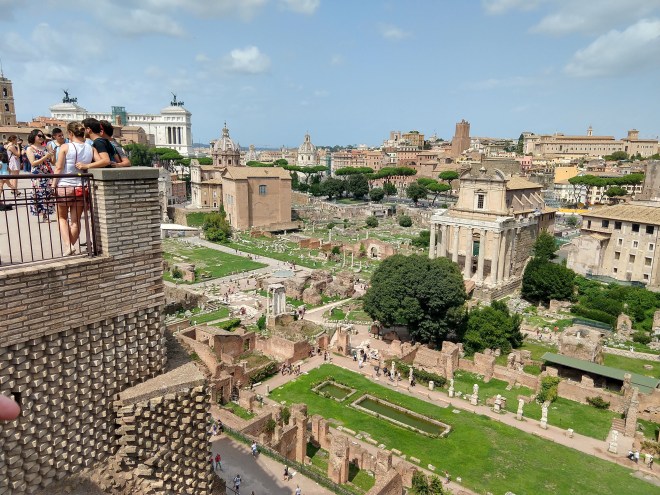
Part of the forum from above, on Palatine Hill.
After exploring Palatine Hill for a while we wandered off into the rest of the city.
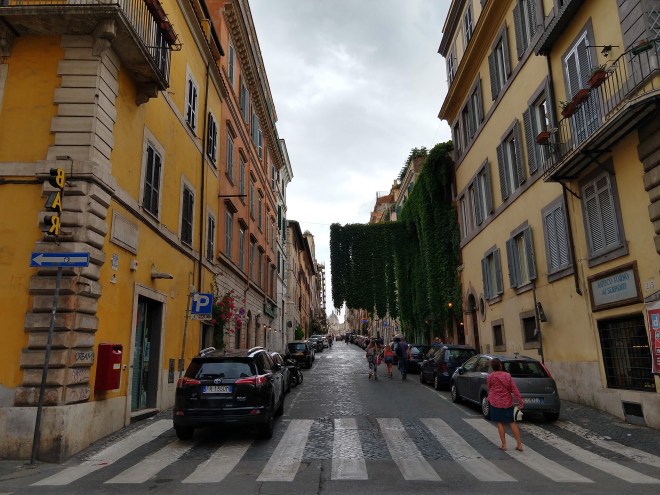
I loved these buildings – and those vines growing! They looked like a curtain 🙂
We soon found Trevi Fountain. When we arrived, it was sprinkling and everyone was looking on with umbrellas…

The famous Trevi Fountain
Soon, it began to pour, and nearly everyone cleared out of the fountain area. We had no where else to go, so we made the most of it with our umbrellas.

Trevi Fountain, with only a few people in the rain.
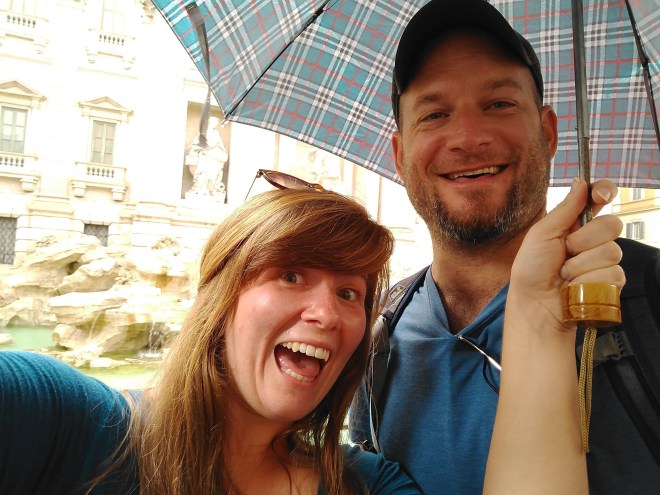
Us in front of the fountain – prior to this I tried to toss a coin in over my shoulder into the fountain – and missed 😂! It hit my umbrella the first time, but the second time I was successful :).
Next, we headed to the Pantheon. This impressive structure has been here since 126 AD, starting as a Roman Temple and eventually being turned into a church. The dome ceiling inside is quite impressive.
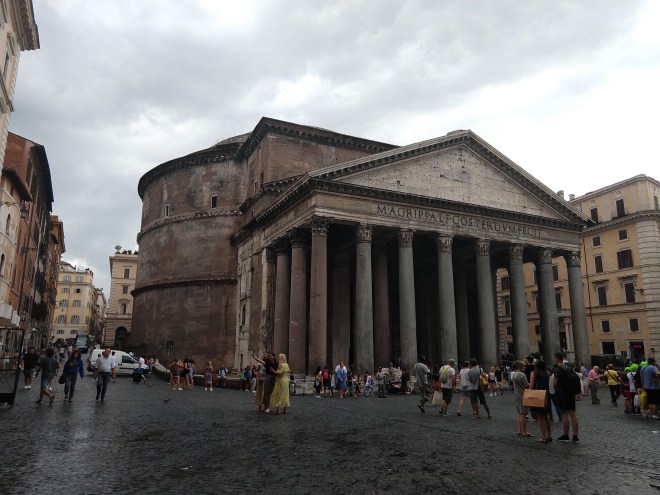
Pantheon – 126 AD

The entrance to the Pantheon – Look at those huge doors!
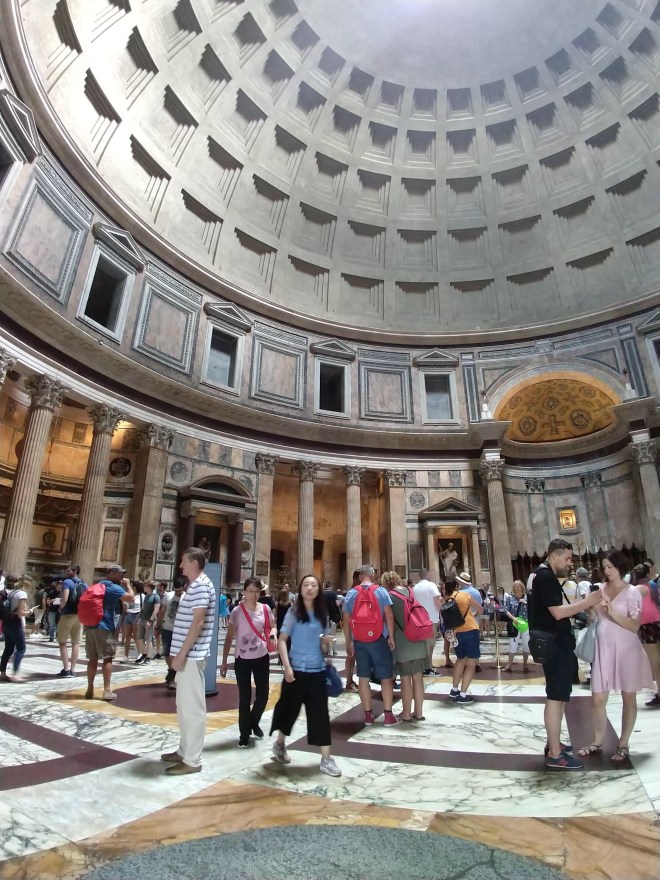
A glimpse at the dome and inside of the Pantheon

A place to sit and reflect or pray in the Pantheon.
After leaving the Pantheon we headed over a few streets to try some delicious gelato. At this place we got apple mint, almond orange, and blackberry…YUM. My favorite flavor we had on the trip was honey walnut basil – that one is certainly worth trying to replicate back home.

Gelato
On the way back to our room we passed by the famous Spanish stairs. I’m still unsure why they are so famous, but there are more of them than it looks in the picture!

The Spanish Stairs
The next day we headed to Vatican City to what is probably the most famous of the four important churches, St. Peter’s Basilica. This church is the largest church in the world, the highest point in the cathedral reaching an enormous 448 feet (that’s over 40 stories tall). However, while being the largest church in the worldly, it is brillantly designed to trick your eyes into believe in it is smaller than it actually is. Nothing can do it justice like seeing it in person, but maybe some of the photos below will give you a good idea of what it’s like.
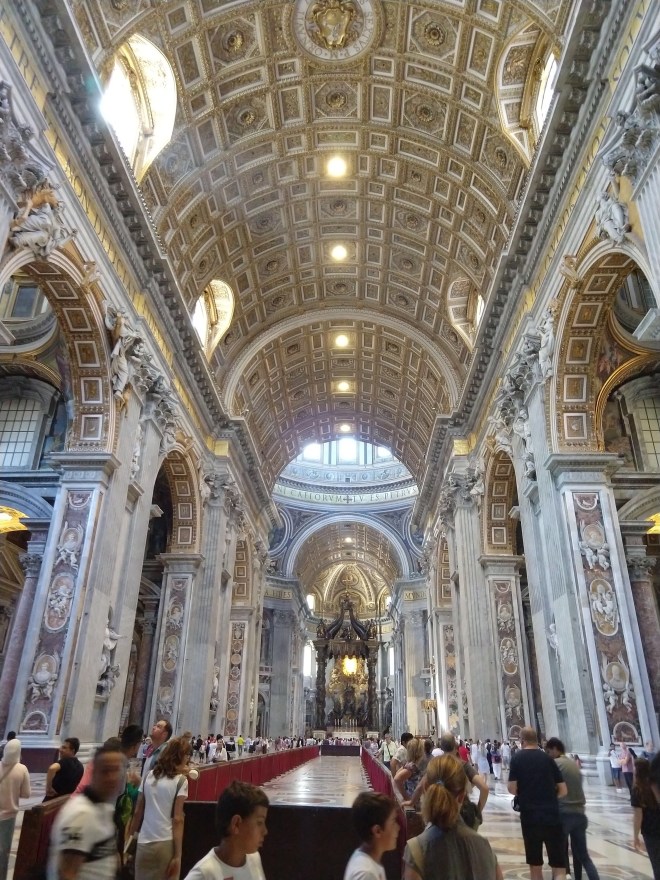
Walking into St. Peter’s Basilica.
The large bronze structure you see right down the middle of the aisle is called a baldacchino. It was designed by the famous by Bernini make the 40 story space between the floor and dome top look smaller. That baldacchino itself is 94.3 feet tall – around 9 stories high – yet somehow it does make the space look smaller.

Statues inside St. Peter’s Basilica.
Even the statues in this building are designed to make the space look smaller. For example, though this bottom statue and top statue look like they are about the same size, the top statue is actually about 6 feet taller than the bottom one (around 21 feet tall!). That way, when a person looks up, things appear closer because they are bigger.
That same tricky planning went into the lettering around the top of the building. All those Latin words you see near the ceiling in all of these pictures are actually 7 feet tall. Crazy, right?
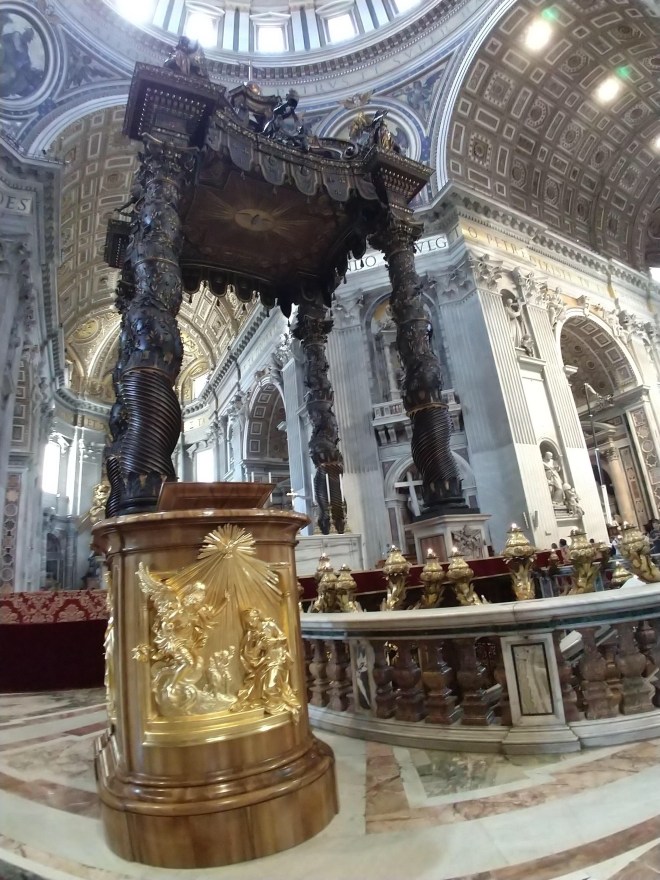
A close up of the baldacchino with the altar next to it. When the pope does preach here, this is where he stands. To the right of the altar is where St. Peter is believed to be buried.
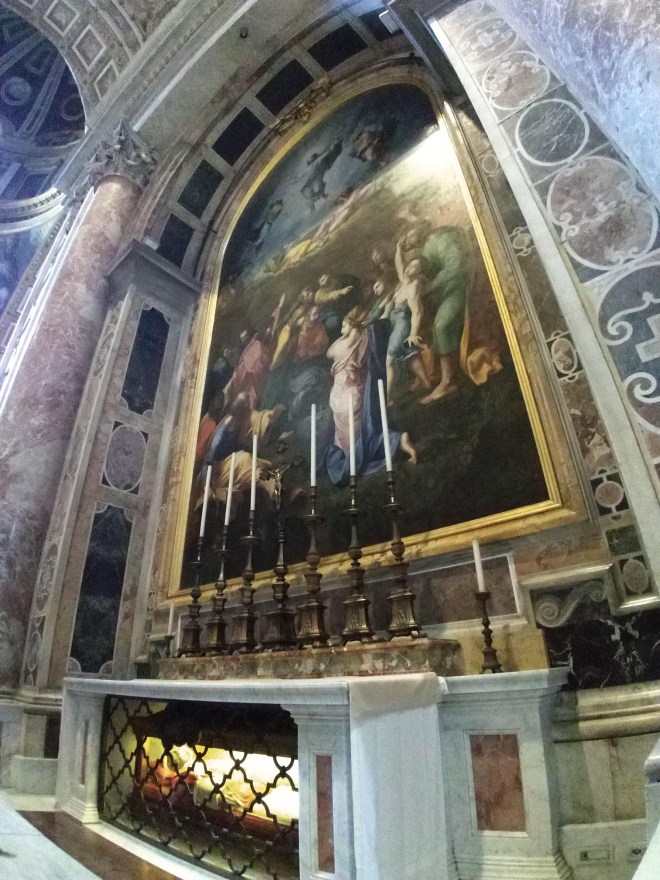
Painting? Nope – that’s a mosaic. Every piece of art in this building that looks like a painting is actually a mosaic. They planned it this way because mosaics don’t fade over time. Below the painting the corpse of a former Pope is on display.
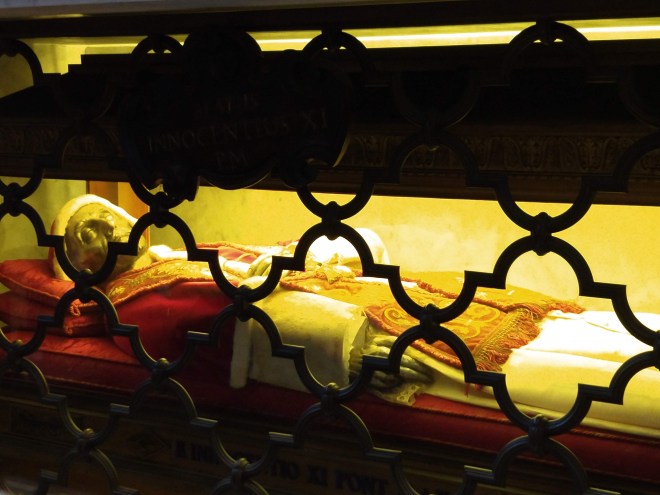
A closer photo of the pope.
Many of the former popes are buried under this basilica. I’m unsure why, but their bodies have been preserved and are brought up and placed on display for various amounts of time. When we went, there were two on display.
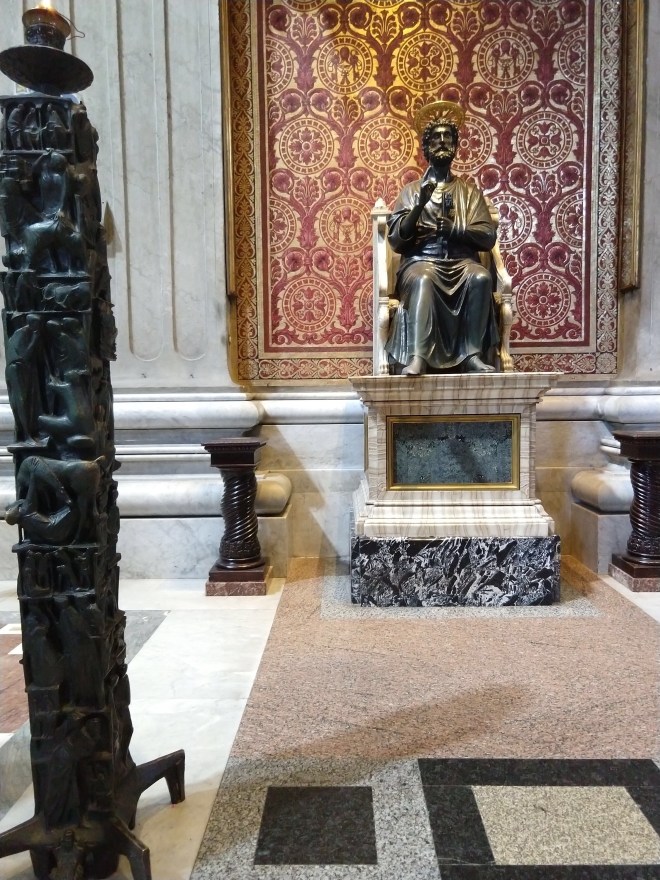
Famous statue of St Peter.
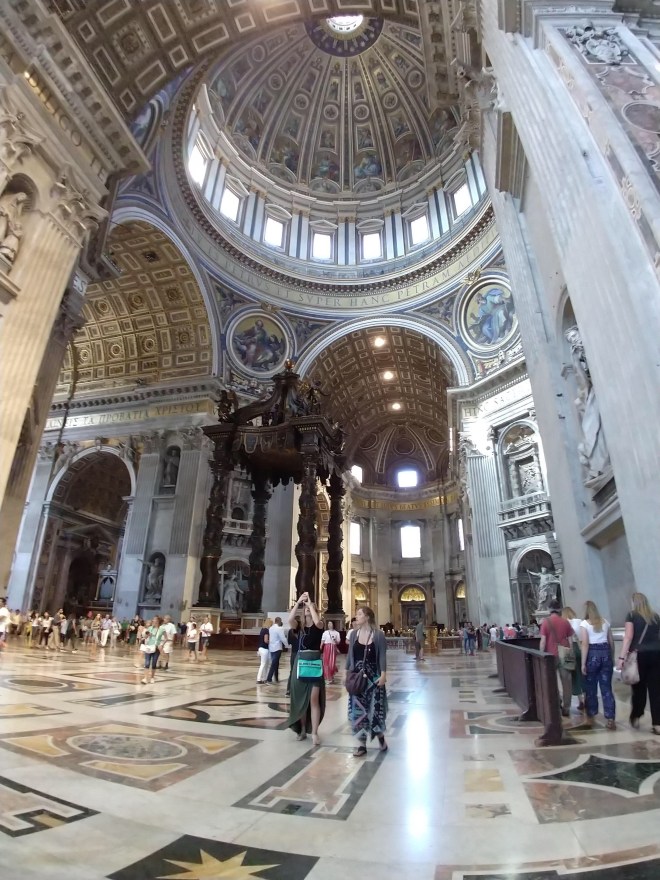
Part of the famous dome by Michelangelo with the baldacchino below.

The holy doors, only opened in holy years (years of jubilee – which occur every 25 years) and during years the pope declares holy.
 The inside of the Holy door remains bricked until it’s time for it to be used.
The inside of the Holy door remains bricked until it’s time for it to be used.

Michelangelo’s famous Pieta, now housed behind bulletproof glass after someone came in and took a hammer to it nearly 50 years ago.
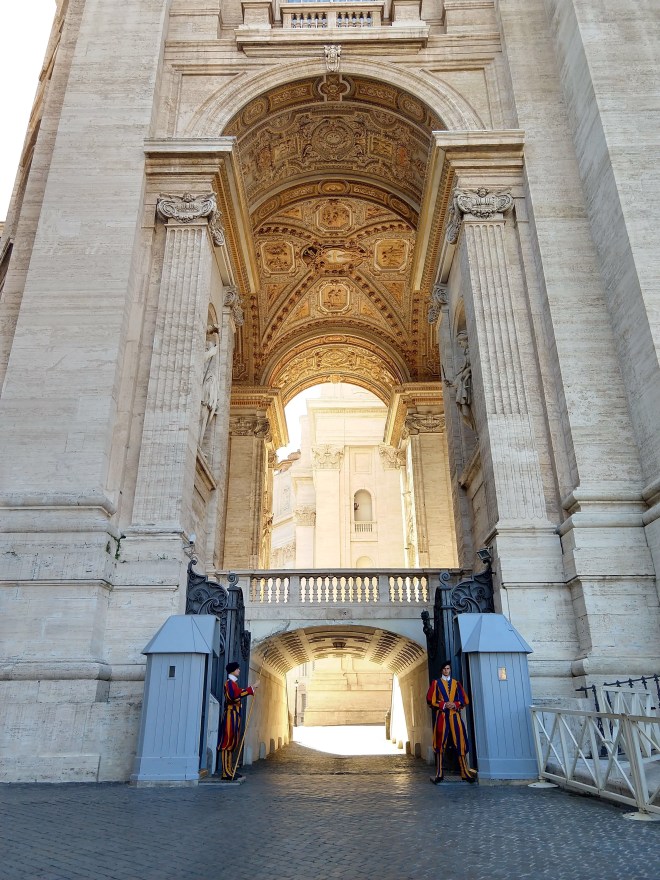
Outside the basilica, the Vatican guards in sight. How fun are their outfits?
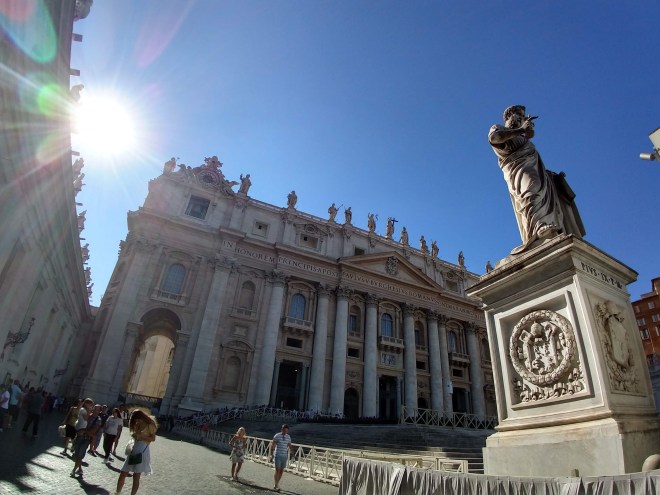
The front of the basilica, statue of Peter in sight.
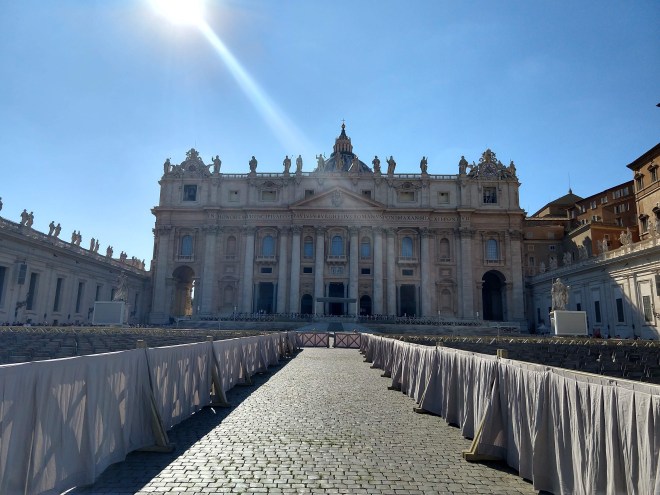
The front of the basilica straight on.
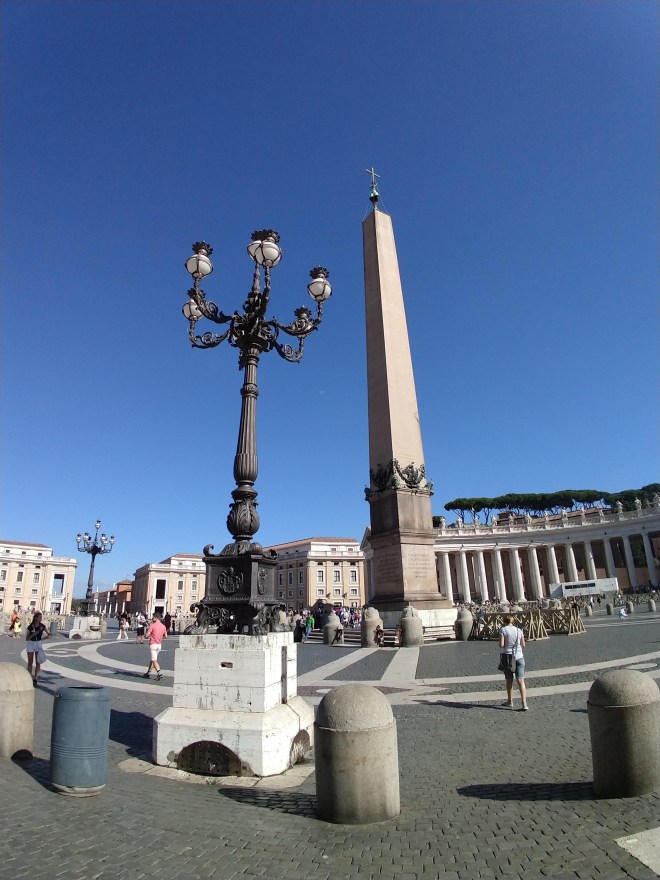
St. Peter’s square in front of the basilica.
The next day I woke up with a fever and sent Kirk to tour the Vatican on his own. Though we didn’t anticipate me getting sick, we had always planned on him visiting the Vatican on his own due to the high cost and me having visited only two years prior.
Visiting the Vatican is like visiting a well planned maze. You are sent with crowds of people through winding hallways full of church art, then through apartments of former popes that have walls covered in paintings, and finally, you arrive at the Sistine Chapel, the star of the show. Below are a few things you see along this journey.

One of the first things you see upon entering the Vatican, a former Roman fountain that predates this land being designed as Vatican City.

Hall of art
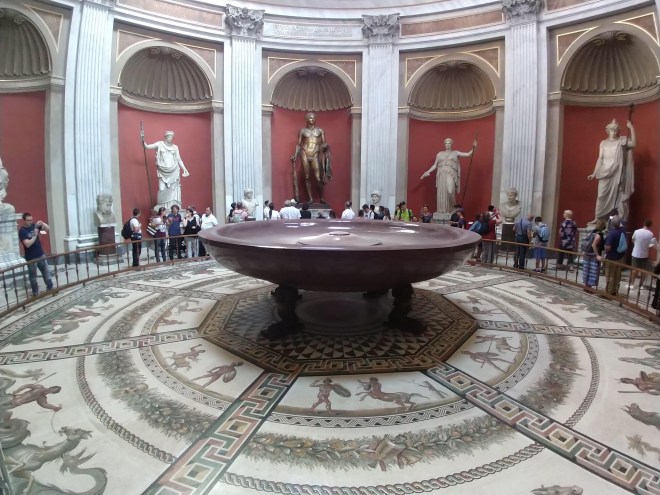
More art – in the Vatican many of the statues that were originally naked now have fig leave covering their privates. Many of the paintings that once had naked individuals were re-vamped to have long cloth wrapped around the bodies.
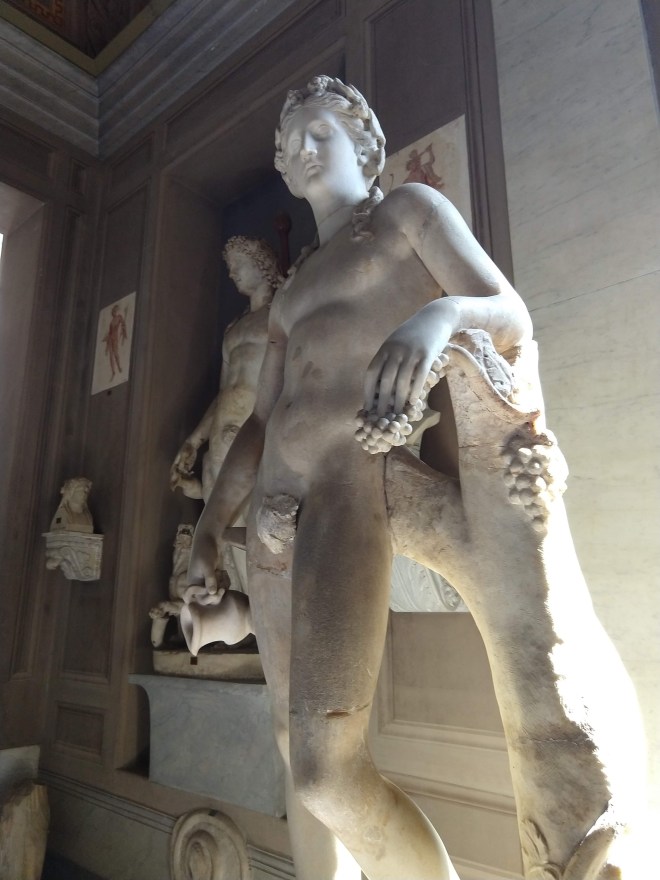
A closer example of a fig leaf added later.
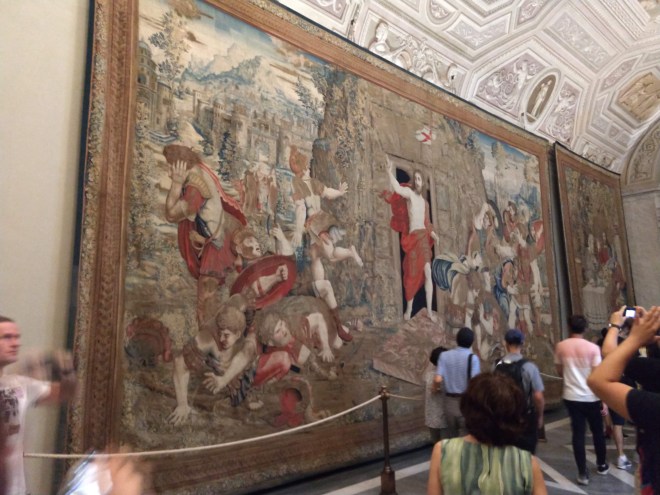
Resurrection painting in the Vatican
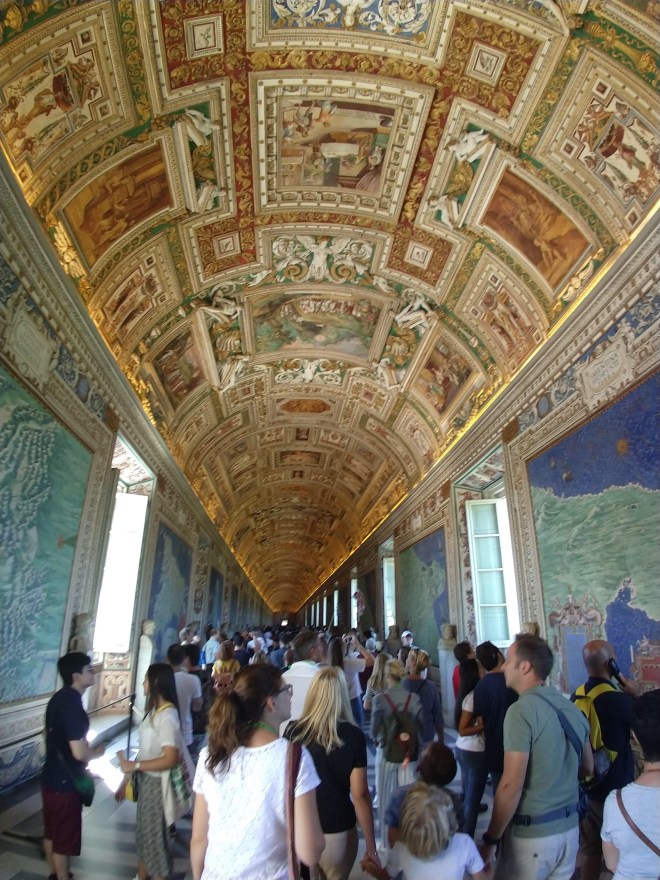
The art filled halls in the Vatican – this particular hall has map paintings and a very decorative ceiling

Map painting

Inside the famous “Room of the Segnatura” which contains Raphael’s most famous works

More of the “Room of the Segnatura”
And finally, though you aren’t supposed to take pictures in the Sistine chapel, Kirk snuck a few to give you a peek.

The ceiling of the Sistine Chapel, Kirk’s forehead in view 😂
Can you imagine how long it would take to paint a space this large? Amazing!
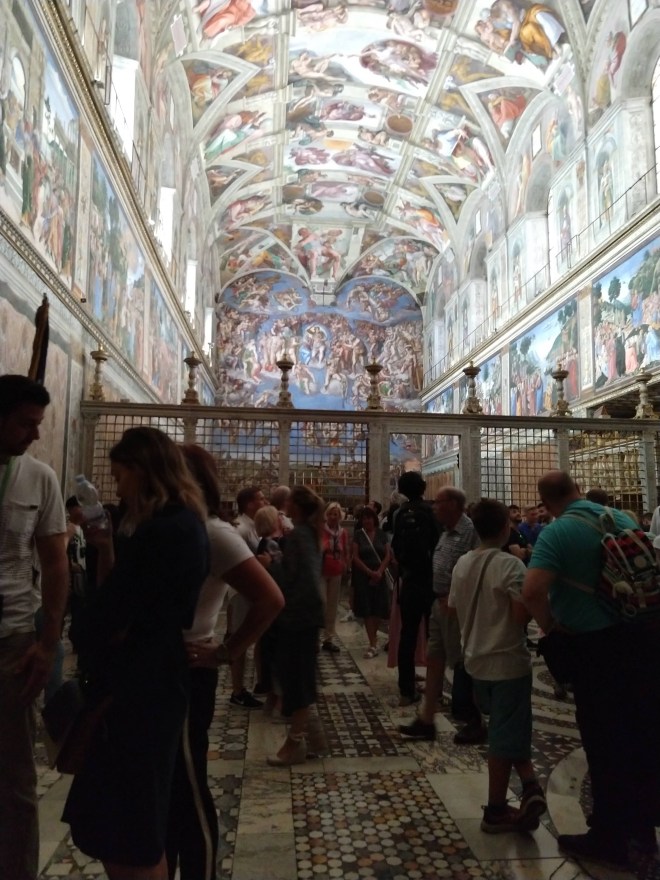
The Sistine Chapel, the painting of the Final Judgement in view
As Kirk left, he snapped a picture of this beautiful staircase
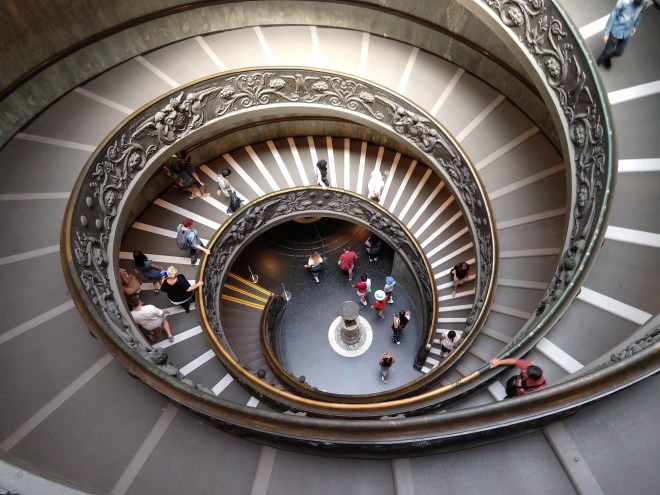
Staircase in the Vatican
Our final outing in Rome was to visit the final of the four important churches there, the Basilica of St. Mary Major.
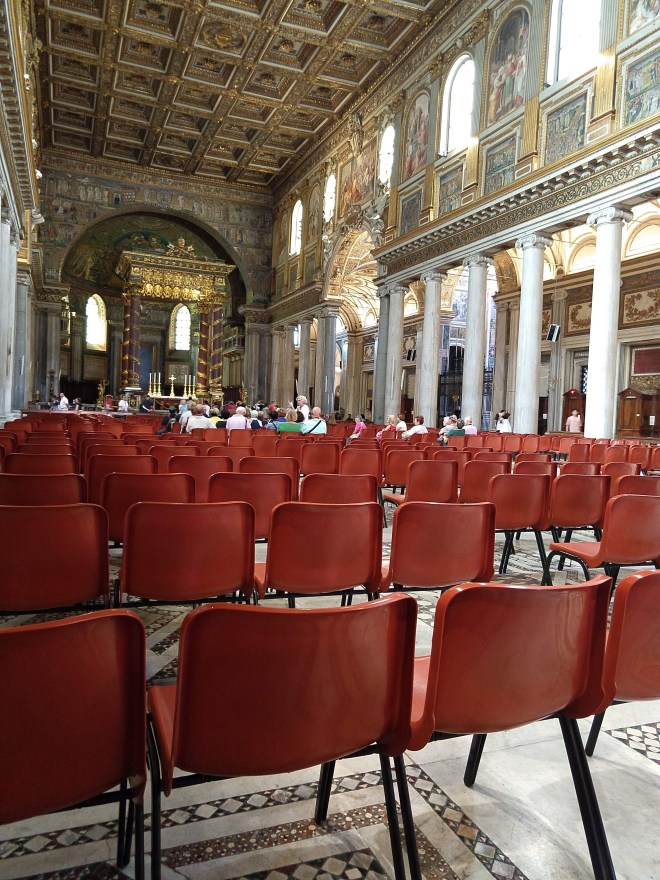
Inside the Basilica of St. Mary Major with the plastic chair put out for services still in place
While wandering around the church we found a glass pane with an interesting design on it. We later learned that this design of a pyramid with an eye in the middle represents the eye of God watching over everyone. It is pictured below.
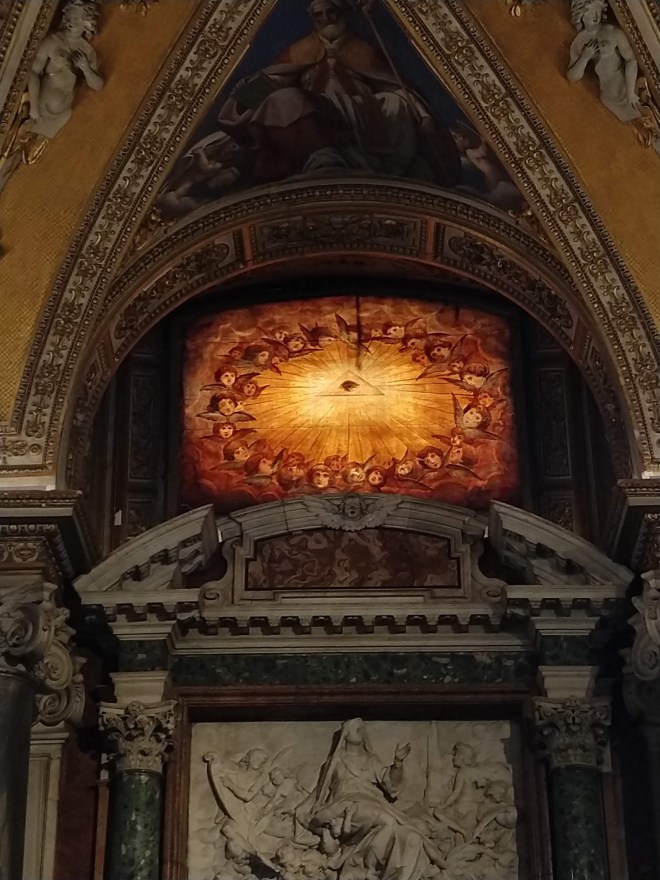
“Eye of Providence”
After touring around Rome we packed up our things and headed to Verona and the Valpolicella Valley. I will pick up there in the next blog!
I leave you with a photo of the Colosseum all lit up at night. It’s quite a beauty!
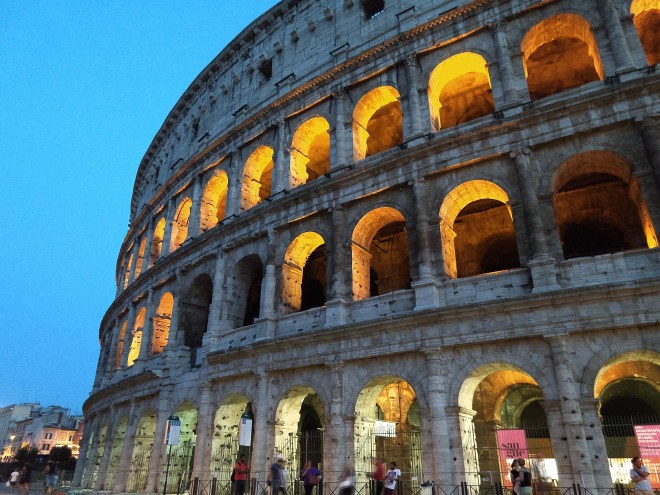
The Colosseum
Wow!! How I enjoyed this!! I went to Rome (and other places) with my dad and others in 1972. It was so fascinating to see your photos and recollect what I could from my visit. 😊
LikeLiked by 1 person